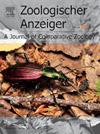Taxonomic novelties within Brazilian pea crab species: a new genus for Pinnixa latissima Coelho, 1997 and reallocation of Pinnixa gracilipes Coelho, 1997 (Pinnotheridae, Pinnixinae)
IF 1.5
3区 生物学
Q2 ZOOLOGY
引用次数: 0
Abstract
Coelho (1997) described three new species of Pinnixa for the Brazilian coast, two of which have remained in the genus until now. Both species, Pinnixa gracilipes and Pinnixa latissima, have never been addressed in taxonomic studies since. Recent phylogenetic and taxonomic studies of the subfamily Pinnixinae have led to new perspectives that resulted in the description of new genera and allocation of some species of Pinnixa to other genera. Given this context, the present study reassesses the taxonomic status of P. gracilipes and P. latissima using morphological data. A new genus Brasilixa gen. nov. is formally described and named herein to accommodate P. latissima, which can be distinguished from other pinnixine genera by the relative width of the carapace, the arc-shaped cardiac ridge, the morphology of the third maxilliped and the presence of spines on the basi-ischium of pereopods 4 and 5. Pinnixa gracilipes is reallocated to Rathbunixa based on shared similarities including the well-defined carapace regions, the presence of a triangular elevation on the cardiac region, slender pereopods and similar male first gonopod morphology. A key to genera and species of Pinnixinae of Brazil is also presented.
巴西豌豆蟹的分类学新异:平蟹科(Pinnotheridae, Pinnixa pinatissima Coelho)一新属(1997)和扁蟹科(Pinnotheridae, pinnitiae)的再分配(1997)
Coelho(1997)描述了巴西海岸的三种新Pinnixa,其中两种至今仍属于该属。这两个物种,长尾松和阔尾松,从未在分类学研究中得到解决。近年来对鳖亚科的系统发育和分类学研究为鳖亚科的新属描述和某些种的归属开辟了新的视角。在此背景下,本研究利用形态学资料重新评估了细叶青和扁叶青的分类地位。本文正式描述并命名了一个新属Brasilixa gen. 11 .,以容纳P. latisima,它可以通过甲壳的相对宽度、弧形心脏脊、第三上颌部的形态以及准足目动物4和5的基坐骨上的刺的存在与其他松毛虫属区分开来。Pinnixa gracilipes被重新分配给Rathbunixa,基于共同的相似性,包括明确的甲壳区域,心脏区域三角形凸起的存在,细长的准足类和相似的雄性第一性腺形态。还给出了巴西平尼蝇科属和种的检索表。
本文章由计算机程序翻译,如有差异,请以英文原文为准。
求助全文
约1分钟内获得全文
求助全文
来源期刊

Zoologischer Anzeiger
生物-动物学
CiteScore
2.80
自引率
7.10%
发文量
75
审稿时长
>12 weeks
期刊介绍:
Zoologischer Anzeiger - A Journal of Comparative Zoology is devoted to comparative zoology with a special emphasis on morphology, systematics, biogeography, and evolutionary biology targeting all metazoans, both modern and extinct. We also consider taxonomic submissions addressing a broader systematic and/or evolutionary context. The overall aim of the journal is to contribute to our understanding of the organismic world from an evolutionary perspective.
The journal Zoologischer Anzeiger invites suggestions for special issues. Interested parties may contact one of the editors.
 求助内容:
求助内容: 应助结果提醒方式:
应助结果提醒方式:


